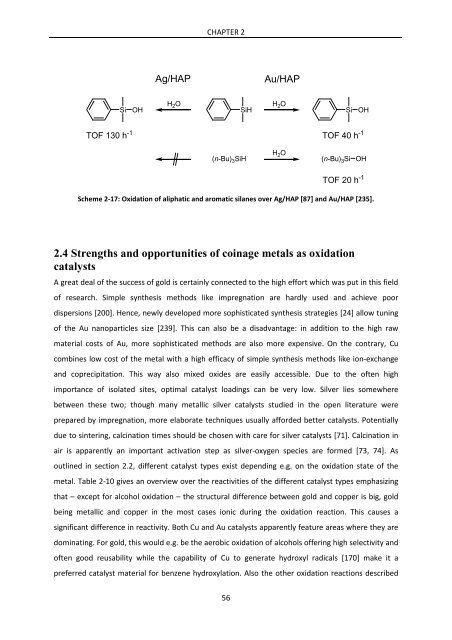Heterogeneously Catalyzed Oxidation Reactions Using ... - CHEC
Heterogeneously Catalyzed Oxidation Reactions Using ... - CHEC
Heterogeneously Catalyzed Oxidation Reactions Using ... - CHEC
Create successful ePaper yourself
Turn your PDF publications into a flip-book with our unique Google optimized e-Paper software.
Si OH<br />
TOF 130 h -1<br />
Ag/HAP<br />
CHAPTER 2<br />
H2O H2O SiH<br />
(n-Bu) 3SiH<br />
Scheme 2‐17: <strong>Oxidation</strong> of aliphatic and aromatic silanes over Ag/HAP [87] and Au/HAP [235].<br />
2.4 Strengths and opportunities of coinage metals as oxidation<br />
catalysts<br />
A great deal of the success of gold is certainly connected to the high effort which was put in this field<br />
of research. Simple synthesis methods like impregnation are hardly used and achieve poor<br />
dispersions [200]. Hence, newly developed more sophisticated synthesis strategies [24] allow tuning<br />
of the Au nanoparticles size [239]. This can also be a disadvantage: in addition to the high raw<br />
material costs of Au, more sophisticated methods are also more expensive. On the contrary, Cu<br />
combines low cost of the metal with a high efficacy of simple synthesis methods like ion‐exchange<br />
and coprecipitation. This way also mixed oxides are easily accessible. Due to the often high<br />
importance of isolated sites, optimal catalyst loadings can be very low. Silver lies somewhere<br />
between these two; though many metallic silver catalysts studied in the open literature were<br />
prepared by impregnation, more elaborate techniques usually afforded better catalysts. Potentially<br />
due to sintering, calcination times should be chosen with care for silver catalysts [71]. Calcination in<br />
air is apparently an important activation step as silver‐oxygen species are formed [73, 74]. As<br />
outlined in section 2.2, different catalyst types exist depending e.g. on the oxidation state of the<br />
metal. Table 2‐10 gives an overview over the reactivities of the different catalyst types emphasizing<br />
that – except for alcohol oxidation – the structural difference between gold and copper is big, gold<br />
being metallic and copper in the most cases ionic during the oxidation reaction. This causes a<br />
significant difference in reactivity. Both Cu and Au catalysts apparently feature areas where they are<br />
dominating. For gold, this would e.g. be the aerobic oxidation of alcohols offering high selectivity and<br />
often good reusability while the capability of Cu to generate hydroxyl radicals [170] make it a<br />
preferred catalyst material for benzene hydroxylation. Also the other oxidation reactions described<br />
56<br />
Au/HAP<br />
H 2O<br />
Si OH<br />
TOF 40 h -1<br />
(n-Bu) 3Si OH<br />
TOF 20 h -1



